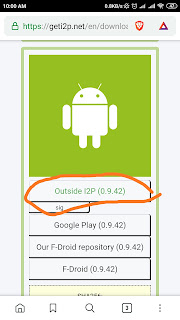Introduction to the i2p darkweb
What is a Darkweb?
Darkweb is often times a computer network that require special software and/or authorization to access contents within them. They are an overlay network of computer that exist on top of the normal internet. You can simply imagine them as a big VPN network, but instead, they anonymize all the computers in the network using various techniques such as Onion Routing, Garlic Routing and Content fragmentation and distribution over all the nodes, etc. They are mostly peer to peer decentralized networks with exception being Tor. People use these darkweb mostly for privacy and anonymity. Because they are anonymous, they have also been favored by criminals to perform their illicit activities. However, thanks to Police raid, their percentage fairly remains low. Some of the example of popular Darkweb networks are Tor, I2p, FreiFunk, NetSukuku, and many others... In this blog however, I will only focus on I2p, mainly because I believe it doesnt get as much appreciation as it deserves.
What is I2p?
I2p stands for the Invisible Internet project, classified as a darkweb. It works in the principle of garlic routing to anonymize the users who use the service. All communication is end to end encrypted (in total there are four layers of encryption used when sending a message), and even the end points ("destinations") are cryptographic identifiers (essentially a pair of public keys).How does it work?
As previously explained, it uses garlic routing to anonymize its users. Garlic routing mechanism is built on top of Onion routing mechanism. The fundamental difference in Onion routing and garlic routing is that Garlic routing focuses on bundling of messages together before passing it to the next node. It is also important to note that it is unidirectional and closed network, ie. You have different tunnel for incoming(inbound) and outgoing(outbound) connections and you cannot browse websites out of the i2p system. However, recently there are outproxies that allow you to browse out of the i2p ecosystem. |
| Fig: How i2p works |
The figure above shows the working of i2p, more specifically, the garlic routing. Say for example, user A using computer 1 wants to send the data "A" to user B in computer 4. S/he first sends that message through his/her outbound tunnel connecting computer 2. Say, the user at computer 2 wants to send the message "B" to computer 7. The two messages by user "A" and user "B" will be bundled together before being sent to user "C". When the message reaches computer 4, computer 4 only decrypts s/her share of message and passes the rest of the bundle to the next computer. The cycle continues.
How is it different from Tor?
There are subtle fundamental differences between I2p and Tor, most obvious being that i2p is decentralized while Tor is centralized. In Tor, the DNS server is referred to as 'Directory Server' which is centralized. In i2p, it is known as 'NetDB' which is decentralized meaning it is resilient to network failure in case of multiple inbount tunnes being used. Not to mention, it is more optimized for hidden services than tor is. Tor has its official Tor browser, while you need to configure your own browser to use i2p, for this reason, i2p is generally inhabited by tech-savy individuals rather than mostly spammers and criminals. That doesnt mean i2p is free from criminals, which it isntI2p will randomly delay your packets and bundles them to prevent from correlation attacks that Tor is still vulnerable with. And least and obvious difference is that Tor uses .onion extension for its hidden services while i2p uses .i2p.
How is it different from the conventional internet?
One of the most obvious difference to notice is that there is no such thing as ipv4 addresses in the i2p network, instead, every device on the network is given a 512(sometimes more or less) character hash to identify that particular node in the network. For the sake of simplicity, one can use the base64 or base32 version of that long hash to reduce the space it takes.
I2p address book
In I2p, unlike normal internet, you need to know the long address before you can access that website. This is just like how you need to have a phone number of the person you want to dial. You can also subscribe to other people's address book but you need to trust that person before you do so. Fortunately, there are some well trusted address book providers that can provide you with this information.
Page 2: Download and install I2p on your computer
If you want to install I2p on an android phone instead, You may wish to goto Download, Install and configure I2p on Android
Or, if you have already installed i2p on your desktop, you may want to jump directly to Page 3: Configuration and Post Installation


Hey guys, by now we all know that buying and selling things on the deep web is mostly fake!
ReplyDeleteBut still some are LEGIT! .